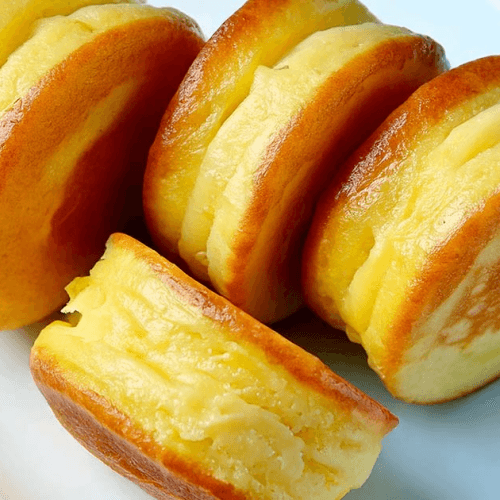Imagawayaki is one of the signature treats of Japan. It’s filled with delicious red bean paste. This anko paste is found in many Japanese desserts like mochi, yokan, and dango.
Contents
Imagawayaki – red bean paste pancake recipe
Imagawayaki or Obanyaki is a popular and delightful Japanese confection. These sweet street foods are pancakes filled with red bean paste. They have a distinctive round shape with a pattern on both sides.
Imagawayaki significantly influences street food culture. It is a staple at Japanese festivals and events. The treat offers traditional flavors at local and national festivals. While similar in concept, Imagawayaki is different from Taiyaki:
- Obanyaki is round. Taiyaki is fish-shaped.
- This pancake is usually thicker and fluffier.
- Obanyaki’s filling is more uniformly distributed.

The name “Imagawayaki” comes from Imagawa Street in Tokyo. The snack became popular in the early 20th century. The filling is sweet red bean paste in two varieties. Tsubuan is chunky red bean paste with bean pieces, while Koshian is smooth, strained red bean paste.
These Japanese dessert pancakes shine when paired with traditional drinks like matcha, sencha, or hojicha. Jasmine tea, sweet rice drink, and mugicha also complement their flavors.
For a modern twist, you can try bold espresso or a glass of milk to enhance sweet fillings. Vanilla ice cream or hot chocolate pairs perfectly with chocolate or custard-filled Obanyaki.
The traditional recipe uses the red bean paste. However, I switched to the custard cream filling. You can make these sweet Obanyaki pancakes without an Imagawayaki pan. A 4-cup egg frying pan, like the picture below, is enough. Here’s how to make Imagawayaki:


Gluten-free Imagawayaki or Obanyaki
Nutrition
Equipment
- 1 4-cup egg frying pan
Ingredients
- 1 cup flour I used the gluten-free one. You can use all-purpose flour
- 1/2 cup sugar
- 1/2 tsp baking powder
- 1/4 tsp baking soda
- 1/4 tsp salt
- 2/3 cup milk
- 1 large egg
- 1 tsp vanilla extract
- 1 cup custard cream or store-bought vanilla pudding
Instructions
- In a large bowl, whisk together the flour, sugar, baking powder, baking soda, and salt.
- In a separate bowl, whisk together the milk, egg, and vanilla extract.
- Pour the wet ingredients into the dry ingredients and stir until just combined. Be careful not to overmix; a few lumps are okay.
- Heat the 4-cup egg frying pan over medium heat. Lightly grease each cup with cooking spray or a small amount of oil.
- Pour a small amount of batter into 2 cups, filling it about halfway. Cook them for 2 minutes.
- Add 1 tablespoon of custard cream into the middle of each cooking batter in the pan.
- After 2 – 3 minutes, pour batter into the other 2 cups (about 1/3 full). Cook for 2 more minutes.
- Use a spatula, fork, or chopsticks to lift the filled pancakes and place them on top of the unfilled ones, filling side down.
- Press them down gently and cook for 2 – 3 minutes.
- Remove the Imagawayaki from the pan. Repeat this process until all the batter is used up.
Notes
- Heat it in the microwave at medium power for about 10-20 seconds.
- Wrap it in aluminum foil and place it in the oven for 5-10 minutes at around 300°F or 150°C.
- Steam it for a few minutes until it’s heated through. This method helps maintain the soft texture.
Variations
Below are some notable variations and creative twists on this classic dessert.
- Filling variations
- Sweet Fillings include custard, chocolate, matcha-flavored cream, and fruit fillings like mango, peach, blueberry, and strawberry.
- Savory Fillings consist of cheese and ham, spinach and feta cheese, and Mozzarella cheese with marinara sauce.
- Combined Fillings include custard and fruit preserves or red bean paste and chocolate.
- Regional variations
- Imagawayaki in cold regions is heartier with more stuffing. The pancake in warmer areas features refreshing fruit mixtures.
- Hokkaido Imagawayaki features fresh dairy fillings.
- Kyoto variations include matcha or hojicha flavors.
- Famous Regional Specialties: The pancake has regional variations across Japan. Some notable examples include:
- In Osaka, Obanyaki is a larger version often filled with multiple ingredients.
- Nagoya version (called Ogura Toast) is an open-faced style topped with red bean paste.
- Hokkaido variation (called Yuki Daruma) stands out with its snowman shape and white bean paste filling.
- Kyoto variation (called Otabe) has a smaller size and delicate flavors.
Tips and tricks
Here are several key tips for successful homemade cream custard Obanyaki:
- Tips for Success:
- Ensure batter consistency resembles pancake batter for best results.
- Measure anko carefully to prevent overflow during cooking.
- Use gentle, swift motions when flipping to keep the pancake’s shape.
- Common Mistakes to Avoid:
- Flipping too early causes pancakes to break and leak.
- Avoid overstuffing to prevent spillage and uneven cooking.
- Ensure even heat to achieve consistent browning.



